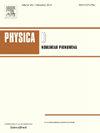一种新的一般耦合(1+1)维长波短波共振相互作用系统:推导、亮孤子和能量共享碰撞
IF 2.9
3区 数学
Q1 MATHEMATICS, APPLIED
引用次数: 0
摘要
利用多尺度摄动方法,从非线性光学中出现的三分量一般耦合Schrödinger系统出发,导出了一个具有四波混频效应的两短波一长波非线性共振相互作用的可解物理系统。然后利用Hirota双线性化方法,在一维上得到了一般耦合长波短波共振相互作用系统的Gram行列式的亮多孤子(如N)解。本工作的主要重点是观察在新的一般耦合(1+1)维长波短波共振相互作用系统中,FWM效应对两个亮孤子、三个亮孤子碰撞和一个束缚孤子与一个标准孤子碰撞的重要作用。该系统在短波分量中具有两种不同的能量共享碰撞,可以通过调节四波混频项的系数进行相互切换,而长波分量中的孤子总是经历弹性碰撞并伴有相移。例如,即使在没有自相位调制和交叉相位调制效应的情况下,FWM的存在也使获得更大范围系统参数的非奇异解成为可能。本文还探讨了三孤子动力学和束缚态孤子的传播。本文章由计算机程序翻译,如有差异,请以英文原文为准。
A new general coupled (1+1) dimensional long wave short wave resonance interaction system: Derivation, bright solitons, and energy sharing collisions
A new solvable physical system describing nonlinear resonant interaction between two short waves and one long wave with four wave mixing (FWM) effect is derived from the three component general coupled Schrödinger system arising in nonlinear optics, by multiple scale perturbation method. Then by using the Hirota bilinearization method, bright multisoliton (say, N) solution of the general coupled long wave short wave resonance interaction system in one dimension is obtained in the Gram determinant form. The primary focus of this work is to observe the significant role of the FWM effect on the collisions between two bright solitons, three bright solitons, and the collision between a bound soliton and a standard soliton in the new general coupled (1+1) dimensional long wave short wave resonance interaction system. The system features two different energy sharing collisions in short wave components that can be inter switched by tuning the coefficient of four-wave mixing terms whereas solitons in the long wave component always undergo elastic collision accompanied by a phase shift. The presence of FWM enables the possibility of obtaining nonsingular solutions for a wider range of system parameters, for instance, even in the absence of self-phase modulation and cross-phase modulation effects. Three soliton dynamics and bound state soliton propagation are also explored.
求助全文
通过发布文献求助,成功后即可免费获取论文全文。
去求助
来源期刊

Physica D: Nonlinear Phenomena
物理-物理:数学物理
CiteScore
7.30
自引率
7.50%
发文量
213
审稿时长
65 days
期刊介绍:
Physica D (Nonlinear Phenomena) publishes research and review articles reporting on experimental and theoretical works, techniques and ideas that advance the understanding of nonlinear phenomena. Topics encompass wave motion in physical, chemical and biological systems; physical or biological phenomena governed by nonlinear field equations, including hydrodynamics and turbulence; pattern formation and cooperative phenomena; instability, bifurcations, chaos, and space-time disorder; integrable/Hamiltonian systems; asymptotic analysis and, more generally, mathematical methods for nonlinear systems.
 求助内容:
求助内容: 应助结果提醒方式:
应助结果提醒方式:


